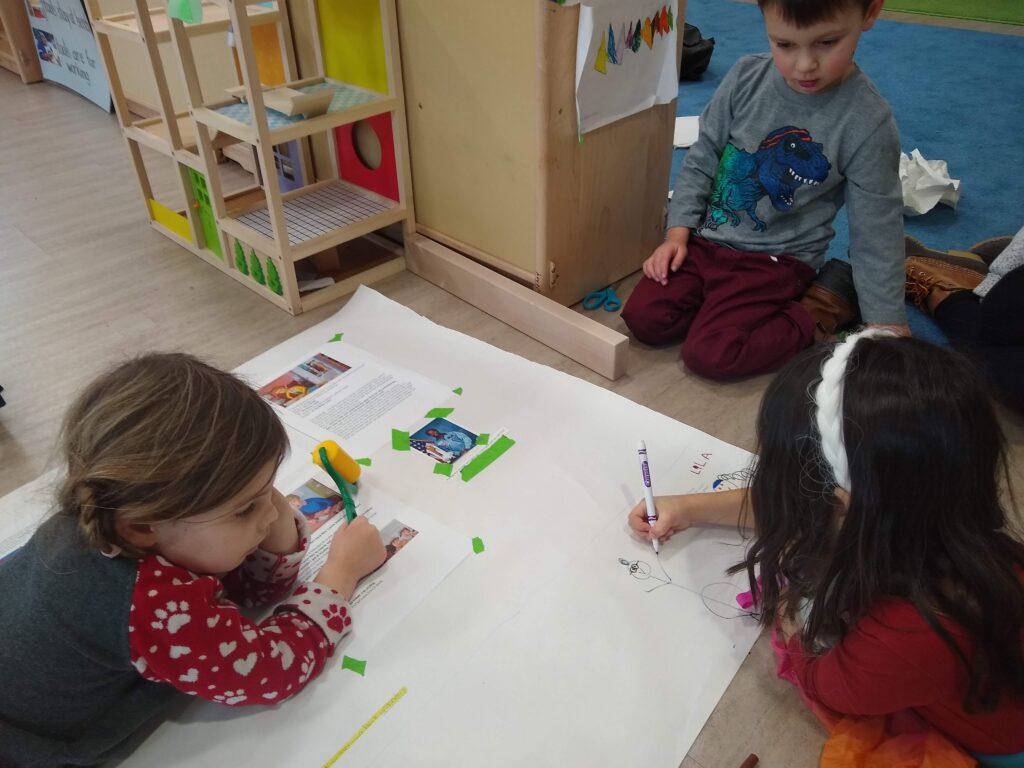
Inspired by the book, Ron’s Big Mission and the discussions that followed, Wonder School students draw pictures of upstanders they know. Drawings include historical figures such as Harriet Tubman, their own grandparents and even themselves
In the previous post from our on-going series about about anti-racist teaching with young children, we shared a snapshot of what anti-racist teaching looks like in our mixed age (3 to 5 yrs) classroom at Wonder School. Because every context and kid is different, I also wanted to take a moment to pull out a few common themes and approaches that have been useful when talking about racism and other tough topics with kids. (Note: while this series and the examples we share are focusing primarily on anti-racist teaching, these approaches work when talking about all kinds of injustices, from ageism and ableism to environmental justice and beyond.)
Start with relationships. While we make race conscious choices in all aspects of our classroom set up from day 1, we hold off on initiating potentially heavy conversations until after we have a chance to build trust with families and get to know our kids.
Know your kids- individually and as a group: Every kid is different, and every group of kids is different. In our pilot year, for example, the group as a whole loved big, juicy group discussions, meaning a lot of our most important conversations happened during group times. The following year, even though we had many of the same kids, the whole group dynamic was different. It took several failed big-group discussions to figure out that the best time to have meaningful conversations was in small groups on the fringes of play during free-choice time.
All the research, all the time: You do not need to be an expert, however, it is important to dig deep both before you get started and as you continue the investigation. This includes not just facts, but also when sourcing picture books (more about that later), photos and other materials.
Work as a community: If a teacher: plan with other teachers, reach out to teachers in other schools, keep communication with your families open/ask for their thoughts, concerns and ideas. If a parent or caregiver: find friends and fellow parents who are interested in the same work to offer their own feedback and support. This is not work to be done alone. (If White, though, be mindful that when you reach out to friends who are Black/Indigenous/people of color that you’re doing it in a way that is not asking them to do more emotional labor for you)
Keep some kind of record of learning: Whether it’s a quick picture snapped with a phone, notes, videos, audio recording or just taking time to jot down important points at the end of the day, find some way to capture the children’s words as well as your own. Doing so allows you all to look back and build on ideas.
Start with where your kids are at: Rather than assume you know what your kids know, ask questions, then sit back and listen- you might be surprised and it will help you better able to plan entry points
Support (don’t suppress) big feelings: A big part of the “work” of early childhood is to learn how to process feelings in healthy ways. Racism, and the history of how racist policies and attitudes have hurt people, is awful. There will likely be confusion, anger and even tears. As best you can, validate whatever feelings come up (“It makes me sad how unfair that rule was too.”) and show children that you are a safe person to have strong feelings around. This also goes for your own feelings as well. Racism is ugly, and dismantling it is hard, emotional work. and It’s okay for your kids to see you working through your own feelings.
“Nothing Without Joy”: Allowing space for big, hard feelings does not mean you all have to stay stuck in them forever. Whenever you can, point to moments of resilience, resistance and creativity. Oppressed people and their allies have a long history of transforming trauma into beauty and liberation. Celebrate that, and fill your world (whether it’s home or the classroom) with joyful and wondrous stories and art featuring BIPOC protagonists and white co-conspirators doing things like going to birthday parties, having adventures and raising dragons.
This post is part of an ongoing series of blog posts unpacking each of our main strategies behind anti-racist teaching with young children. In each we will share resources, including documentation from the classroom, picture books, artwork from the collection and links to resources that have been invaluable in our own efforts.
